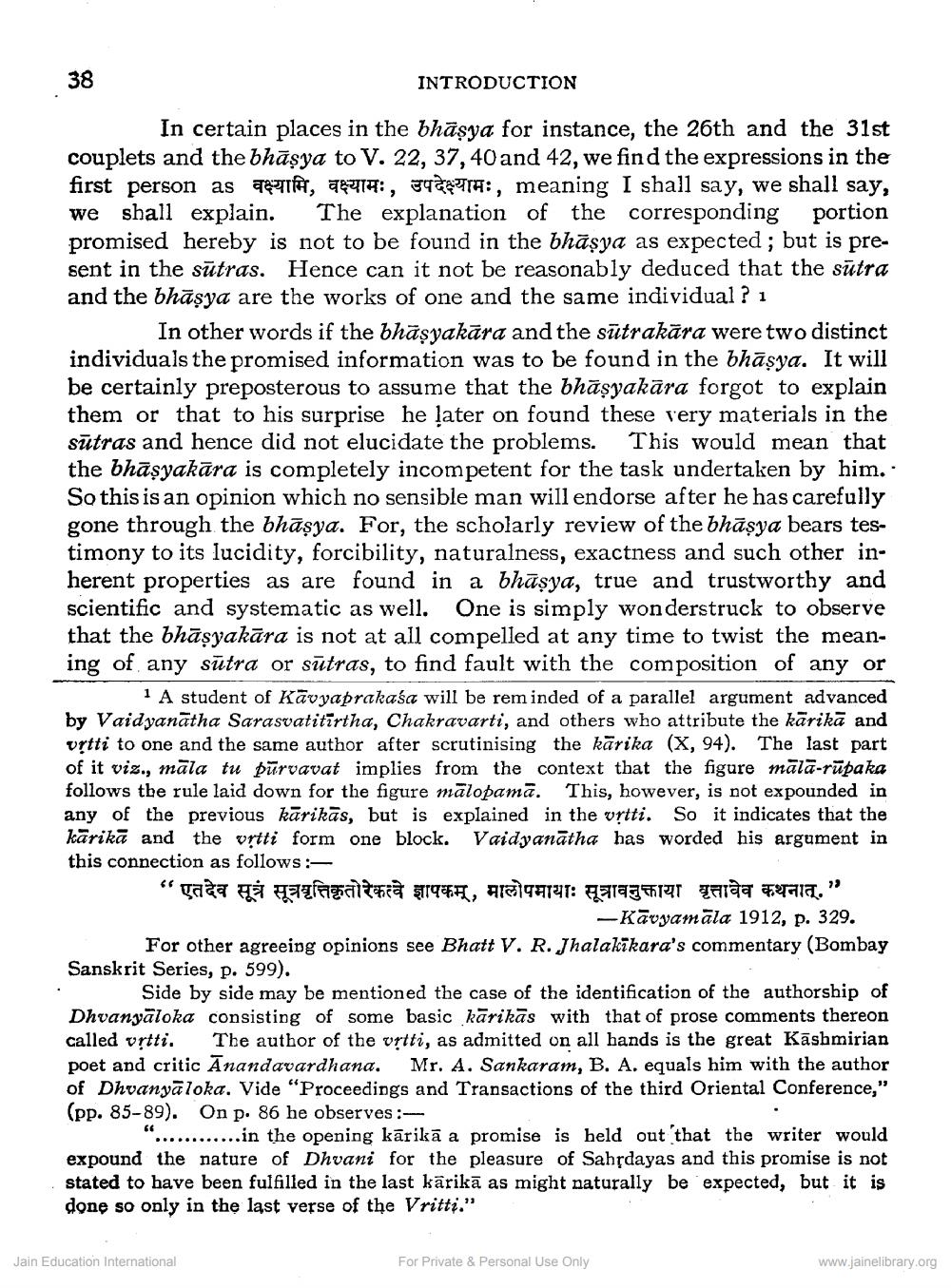________________
INTRODUCTION
In certain places in the bhāsva for instance, the 26th and the 31st couplets and the bhāsya to V. 22, 37,40 and 42, we find the expressions in the first person as I, 914: , 392TA:, meaning I shall say, we shall say, we shall explain. The explanation of the corresponding portion promised hereby is not to be found in the bhāşya as expected; but is present in the sūtras. Hence can it not be reasonably deduced that the sūtra and the bhāsya are the works of one and the same individual ? 1
In other words if the bhāsyakāra and the sūtrakāra were two distinct individuals the promised information was to be found in the bhāsya. It will be certainly preposterous to assume that the bhāsyakāra forgot to explain them or that to his surprise he later on found these very materials in the sūtras and hence did not elucidate the problems. This would mean that the bhāsyakāra is completely incompetent for the task undertaken by him.. So this is an opinion which no sensible man will endorse after he has carefully gone through the bhāşya. For, the scholarly review of the bhāṣya bears testimony to its lucidity, forcibility, naturalness, exactness and such other inherent properties as are found in a bhāsya, true and trustworthy and scientific and systematic as well. One is simply wonderstruck to observe that the bhāsyakāra is not at all compelled at any time to twist the meaning of any sutra or sūtras, to find fault with the composition of any or
1 A student of Kāvyaprakasa will be reminded of a parallel argument advanced by Vaidyanātha Sarasvatitirtha, Chakravarti, and others who attribute the kārikā and vrtti to one and the same author after scrutinising the kārika (X, 94). The last part of it viz., māla tu pūrvavat implies from the context that the figure mālā-rūpaka follows the rule laid down for the figure malopamā. This, however, is not expounded in any of the previous kārikās, but is explained in the vrtti. So it indicates that the kārika and the vrtti form one block. Vaidyanātha has worded his argument in this connection as follows: "एतदेव सूत्रं सूत्रवृत्तिकृतोरेकत्वे ज्ञापकम् , मालोपमायाः सूत्रावनुक्ताया वृत्तावेव कथनात्."
- Kāvyamāla 1912, p. 329. For other agreeing opinions see Bhatt V. R. Jhalakîkara's commentary (Bombay Sanskrit Series, p. 599).
Side by side may be mentioned the case of the identification of the authorship of Dhvanyāloka consisting of some basic kārikās with that of prose comments thereon called vrtti. The author of the vrtti, as admitted on all hands is the great Kāshmirian poet and critic Anandavardhana. Mr. A. Sankaram, B. A. equals him with the author of Dhvanyaloka. Vide “Proceedings and Transactions of the third Oriental Conference," (pp. 85-89). On p. 86 he observes :
............in the opening kārikā a promise is held out that the writer would expound the nature of Dhvani for the pleasure of Sahçdayas and this promise is not stated to have been fulfilled in the last kārikā as might naturally be expected, but it is done so only in the last verse of the Vritti."
brdayas and this promise is not
Jain Education International
For Private & Personal Use Only
www.jainelibrary.org




